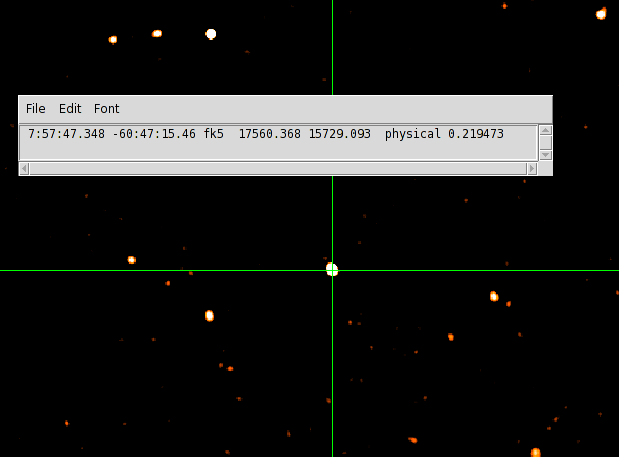[Last Change: 15 Feb 2012 (rev 6)]
Specifying Source Positions
Source positions may be specified in a number of different ways, but they must ultimately resolve into a position relative to the
Chandra optical axis. The standard way of passing source positions to the raytrace is via the
position position argument to an
extent function. The
position argument takes a
Lua table as its value.
Mirror Spherical Coordinates
The Mirror Spherical Coordinate system is a polar coordinate system (θ, φ) fixed to the telescope reference frame. It is centered on the optical axis.
Coordinates for an object in an existing
Chandra observation are most easily obtained by using the
CIAO dmcoords command to determine the
theta and
phi coordinate values.
As an example, here's a close-up of an HRC-I observation of NGC 2516 (OBSID 27). I've decided to simulate the indicated object and use
ds9 to determine its SKY coordinates.
dmcoords provides the MSC
theta (in arcminutes) and
phi (in degrees) coordinates:
% dmcoords infile=/data/hrc/i/00027/analysis/hrcf00027_evt2.fits.gz \
asolfile=/data/hrc/i/00027/primary/pcadf066989205N003_asol1.fits.gz \
x=17560 \
y=15729 \
option=sky
% pget dmcoords theta phi
2.956520430906318
302.0712805942328
The position is provided to
SAOTrace as a
Lua table given as the
position argument to an
extent function:
point{ position = { theta = 2.956520430906318, phi = 302.0712805942328 }, ... }
SAOTrace defaults to units of
arcminutes for θ and
degrees for φ. To specify other units, see
here
.
Celestial Coordinates
Source positions may also be specified in equatorial celestial coordinates. This is more involved than specifying positions in Mirror Spherical Coordinates, as the orientation of the telescope with respect to the celestial coordinate frame is required.
The following information is required:
- The source position.
- The optical axis position. For an existing observation this is available from
- the
RA_NOM and DEC_NOM keywords in the header of an event file; or
- via the
CIAO dmcoords command, by determining the center of the field in celestial coordinates.
- The telescope roll. This is available for an existing observation from
- the
ROLL_NOM keyword in the header of an event file
In the above example using NGC2516, the object has
| RA |
= 7:57:47.348 |
| Dec |
= -60:47:15.46 |
| RA_NOM |
= 1.1953549452648E+02 |
| DEC_NOM |
= -6.0763660833014E+01 |
| ROLL_NOM |
= 3.3121684998055E+02 |
The position is provided to
SAOTrace as a
Lua table given as the
position argument to an
extent function:
point{
position = { ra = '7:57:47.348',
dec = '-60:47:15.46',
ra_aimpt = 1.1953549452648E+02,
dec_aimpt = -6.0763660833014E+01
}, ... }
Note that the RA or Dec may be provided either in sexagesimal notation (as strings) or as floating point numbers (default units are
degrees). To specify other units, see
here
.
The telescope roll is specified separately using the
roll() function, which takes as argument the roll in
degrees.
roll( 3.3121684998055E+02 )
The default unit is degrees. For a complete example of this simulation, see
How To Raytrace ASingle Point Source.
 .
.
 .
The telescope roll is specified separately using the
.
The telescope roll is specified separately using the 
